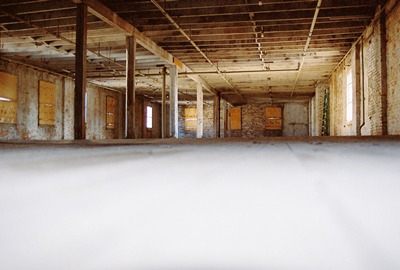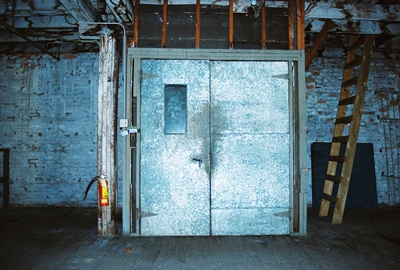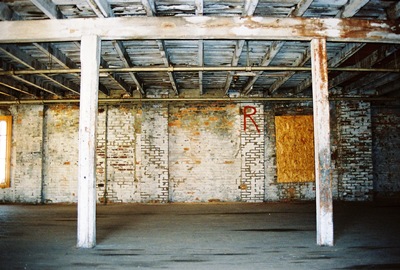
Let’s head north out of the Doughty Building, last post’s feature, and pay a visit to its neighbor at 301-303 James Brown Blvd, the Lowrey Wagon Works aka the Confederate Boot Factory. I passed this vacant and unmarked structure at the corner of 9th and Ellis Streets
 countless times and never gave it a second thought. That was my mistake as the history of this place is fairly fascinating. However, the building is sort of designed to look unassuming. Three stories tall and made of brick, for some reason it was covered in stucco and then scored to look like it was constructed of cinderblock. It’s unassuming alright. And very old. Luckily, Rob Pavey of the Augusta Chronicle did an excellent story on the place in late 2007; most of my information comes from his discussion with Erick Montgomery of Historic Augusta for that piece.
countless times and never gave it a second thought. That was my mistake as the history of this place is fairly fascinating. However, the building is sort of designed to look unassuming. Three stories tall and made of brick, for some reason it was covered in stucco and then scored to look like it was constructed of cinderblock. It’s unassuming alright. And very old. Luckily, Rob Pavey of the Augusta Chronicle did an excellent story on the place in late 2007; most of my information comes from his discussion with Erick Montgomery of Historic Augusta for that piece.
Built in the fall of 1860, initially the building housed the Lowrey Wagon Works only briefly. By April of 1861, with the Civil War beginning, it became a boot factory for the Confederacy. In 1865, after the war, the building was seized by the federal government and given to some local churches to use as a school for freed African-American children. A newspaper noted that the school was "attended by nearly 500 boys and girls" who could "read tolerably well."

The school soon moved to a larger building and, in 1866, J.H. Lowrey returned to his wagon works to make a real go of it for the next 40 years. Lowrey’s red and green wagons were known for their quality and the company claimed they were found “from Viriginia to Mississippi.” “Go on what plantation you will. There, almost as much a part and parcel of the upturned earth of the furrows, there will be found a Lowrey Wagon," read a rather poetic ad in the Augusta Chronicle.

Lowrey did so well that he expanded his manufacturing throughout downtown Augusta and, when he died in 1909, his son, Henry K. Lowrey, took over the company. But, when Henry died in 1925, the business was shuttered. Henry’s grandson and noted Augusta architect, then-90-year-old Lowrey Stulb, told the Chronicle that he visited the wagon works when he was young and saw the wagons being built. "They had a two-horse, a four-horse, and I suppose they made some surreys too," Mr. Stulb said. "The wagons were green and red and had 'Lowrey' painted on the side."
Right after the wagon works shut down, the building was bought by department store magnate J.B. White and used as office space. It also housed a bike shop and,
 clearly, in one of its last incarnations, a restaurant was on the lower level. There is no indication of its name, although the inscription “Good things to eat” remains on an outside wall. What I don’t have a picture of are the two camera obscurae which have been created by two little holes in the plywood covering the windows of the front doors. While mostly projecting the parking garage across the street, they are still eerily beautiful and, like the now-empty Lowrey Wagon Works building itself, known about by only a very few.
clearly, in one of its last incarnations, a restaurant was on the lower level. There is no indication of its name, although the inscription “Good things to eat” remains on an outside wall. What I don’t have a picture of are the two camera obscurae which have been created by two little holes in the plywood covering the windows of the front doors. While mostly projecting the parking garage across the street, they are still eerily beautiful and, like the now-empty Lowrey Wagon Works building itself, known about by only a very few.Thanks to Historic Augusta and the 2012 Augusta Photography Festival for providing access.
Next we’ll visit the fireproof building that was gutted by fire less than two years after its initial construction. Yup, that would be the Marion Building.
No comments:
Post a Comment